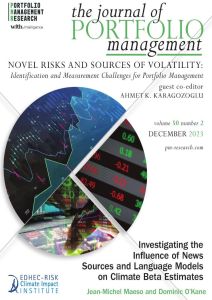

Investigating the Influence of News Sources and Language Models on Climate Beta Estimates
The Journal of Portfolio Management, Novel Risks and Sources of Volatility Special Issue, Vol 50, Number 2, December 2023
Author(s):
Summary:
The Journal of Portfolio Management, Novel Risks and Sources of Volatility Special Issue, Vol 50, Number 2, December 2023
In this article, the authors seek to measure a news-based climate-change beta. Using five language models of increasing sophistication and five high-quality newspaper sources, including the Financial Times, they construct 25 unexpected climate news indices (UCNI). They measure the impact of these UCNI, plus UCNI aggregated over all the news sources, on a range of green, brown, and green-minus-brown (GMB) equity portfolios constructed by sorting S&P 500 Index firms based on their carbon intensity. The authors find that the relationship between the Aggregate UCNI and the brown and GMB portfolio returns is statistically significant over the period from July 2012 to November 2021. This result does not hold for UCNI built from a single newspaper. They find that green firms exhibit only a small, statistically nonsignificant degree of sensitivity to UCNI variations.
Key findings:
- Recent literature has sought to investigate the correlation between climate news andequity market performance, with the aim of quantifying a measure of a so-called climatebeta.
- Using a variety of language models and high-quality English-language newspapersources, including the Financial Times and The New York Times, the authors constructan unexpected climate news index (UCNI) for each model and source. They measurethe impact of these UCNI, plus an aggregate UCNI over all the news sources, on a rangeof green, brown, and green-minus-brown equity portfolios, constructed by sorting S&P500 Index firms based on their carbon intensity.
- For most of the language models considered, the sensitivity of returns to an increasein the corresponding aggregated UCNI is negative and statistically significant at 1% forbrown portfolio returns, but it is not significant for green portfolio returns.
Article accessible in open access here: https://eprints.pm-research.com/17511/102258/index.html?29391
| Type : | Academic Publication |
|---|---|
| Date : | 17/11/2023 |
| Editor : | Portfolio Management Research |

